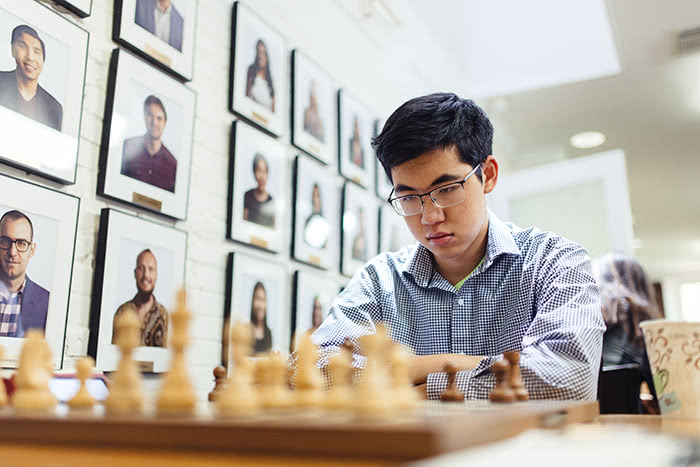The Saint Louis Chess Club is hosting three championships from July 10-21: The U.S. Senior Championship, the U.S. Junior Championship, and the U.S. Girls’ Junior Championship. The senior tournament is for players ages 50 and older. The junior tournaments are restricted to players under age 20 as of January 1, 2019.

This link leads to information about all three championships, including photos and biographies of each player, pairings, standings, rules, and prize funds. Games begin daily at 1 p.m. Central Time (GMT-5), except for a rest day on July 16 and a last round that starts two hours earlier. The commentators are WGM Tatev Abrahamyan, GM Robert Hess, and GM Jesse Kraai. If you are not able to watch the games live, you can replay the games (and the video commentary) at chess24.
July 10th was the opening ceremony. Round 1 was July 11. My favorite tactic of the first round was in the game between GM Andrew Tang and IM Joshua Sheng. By move 47, Sheng (playing Black) is one pawn ahead. But after White’s 47. Qf4, Black won another pawn using a chess tactic called a “decoy.” A decoy is when you win material by enticing an enemy piece to a square where it falls victim to a fork, skewer, or even a checkmate. In this case, Black decoys the white queen to a square where, if it captures the decoy, it will become the victim of a fork. With those hints, look at the position and see if you can find Black’s 47th move.

Courtesy of the Saint Louis Chess Club, Photos by Crystal and Austin Fuller
Three participants in the U.S. Senior Championship may feel nostalgic from being seated near the U.S. Junior Championship. Grandmasters Larry Christiansen, Joel Benjamin, and Maxim Dlugy are all former U.S. Junior Champions. On July 11, Christiansen won in the fewest moves (14) of any competitor in all three championships.
As Christiansen pointed out in his post-game interview with Kraai, Grandmaster Jaan Ehlvest should play either 3….d5 or 4….d5. However, psychologically….d5 is a hard move to play because Ehlvest likely wanted a Pirc Defense formation, which normally includes ….g6, ….d6, and ….Bg7. Christiansen was happy with his classical center after the first few moves. Analyzing a later part of the game, Christiansen said that Ehlvest’s 8.…Qc7 “felt soft…I felt I should get pushy here.” The Stockfish computer engine agrees that Black’s 8….Qc7 changed an almost equal position (.3, which means the equivalent of 1/3 of a pawn ahead for White) to a slight edge for White. Then Christiansen played a blistering attack, which encouraged Ehlvest to resign on move 14. You can hear Christiansen’s analysis of the entire game.
